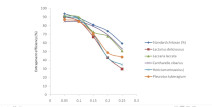Isolation of chitosan from Lactarus deliciousus, Cantharelles cibarius, Laccaria laccata, Hericium erinaceus and Pleurotus tueragium (five wild edible Nigeria mushrooms) for drug delivery application
https://doi.org/10.51412/psnnjp.2022.31
Keywords:
Chitosan, nanoparticles, mushrooms, Drug deliveryAbstract
Background: Nanotechnology is currently being explored as a more efficient tool in drug delivery. The production of chitosan from crustacean shells, lobsters, and shrimps, is associated with several drawbacks. The study is aimed at evaluating drug delivery potentials of chitosan from different wild edible Nigerian mushrooms.
Methods: Chitosan were prepared from the mushrooms by deproteinisation and deacetylation of chitin. Drug delivery potentials of chitosan isolated from different edible wild Nigerian mushrooms was done using standard methods.
Results: The percentage yield of the chitosan revealed that Hericium erinaceus had 61.11±0.01 followed by Pleurotus tueragium with 52.15± 0.01while Cantharelles cibarius had 11.77±0.03 and was followed by Laccaria laccata with 7.18±.0.01. The In-vitro loading capacity was 5-35% and the entrapment efficiency of the chitosan beads with ampicillin at physiological temperature and pH at concentration of 0.05 and 0.1 gave the highest value that compared favorably with each other while at other concentrations, standard and Cantharelles cibarius had high entrapment efficiency. The results of in-vitro releasing capacity indicated that there was an increased release of the ampicillin with time from 5 - 30 minutes and that the ampicillin-loaded formulation obtained after encapsulation exhibited a sustained release behavior in both standard and the mushroom chitosan beads with a steady rise in
cumulative ampicillin.
Conclusion: Mushrooms are potential sources of chitosan and that the isolated chitosan from mushrooms could be use as a vehicle for drug delivery in biological systems.
References
Abdel-Gawad, K, Hifney, A, Fawzy, M, Gomaa, M (2017). Technology optimization of chitosan production from Aspergillus nigerbiomass and its functional activities. Food Hydrocoll, 63:593-6012.
Alsaggaf, MS, Moussa, SH, Tayel, AA (2017). Application of fungal chitosan incorporated with pomegranate peel extract as edible coating for microbiological, chemical and sensorial quality enhancement of Nile tilapia fillets. Int J Biol Macromol., 99: 499-505.
Zapata, PA, Rojas, DF, Atehortua, L (2012). Production of biomass, polysaccharides, dan ganoderic acid using non-conventional carbon
sources mushroom, Ganodrma lucidum, Int J Med Mushrooms, 12(2):197–203,
Shruti, S, Punita, U, Khosa, MA, Tony, M, Abdus, S, Sandra, S, Aman, U (2018). Overview of wastewater treatment methods with special focus on biopolymer chitin - chitosan . Int J Bio l Macromol . https://doi.org/10.1016/j.ijbiomac.2018.10.089,
Ekaterina, B, Roman, B, Ekaterina, L, Leonid, S, Jana, C , Ivan, J, Pavel, K, Andriy, S( 2 0 1 9 ) . Polysaccharides from basidiocarps of cultivating mushroom Pleurotus ostreatus: isolation and structural characterization. Molecules 24(15): 2740,
Kalutharage, NK, Rathnasinghe, DL (2019). A study of chitosan and glucosamine isolated from Sri Lankan local mushroom Schizophyllum commune and oyster mushroom (Pleurotus ostreatus). Mater Today Proc.. https://doi.org/10.1016/j.matpr.2019.07.713,
Stephanie, B, Mihkel, V,Andres, K, James, M (2019). Properties of chitin extracted from Estonian mushrooms. Proc Estn Acad Sci., 68(3):333–336,
Ospina, S, Ramirez, DA, Fernando, D, Zapata, P (2012). Comparison of extraction methods of chitin from Ganoderma lucidum mushroom obtained in submerged culture. Biomed Res Int., 169071,
Marikani, K, Maliga, NK, Rajarathianam, K, Ranjit, S (2010). Production and characterization of mushroom chitosan under solid-state fermentation conditions. Adv Biol Res., 4(1):10–13,
Alona, O, Asier, M Salaberriab, Rita S, Gintautas, S, Murat, K, Jalel, L, Vykintas, B (2019). Physicochemical and in vitro cytotoxic properties of chitosan from mushroom species (Boletus bovinus and Laccaria laccata). Carbohydr Polym, 221:1-9,
Tao, W (2004). Production and characterization of fungal chitin and chitosan. Master's thesis, University of Tennessee,
Rane, KD., Hoover, DG (1993). An evaluation of alkali and acid treatments for chitosan extractionfrom fungi. Process Biochemistry, 28:115–118,
Garg, U, Chauhan, S, Nagaich, U, Jain, N (2019). Current advances in chitosan nanoparticles based drug delivery and targeting. 29(2): 195–204,
Elem, RC and Uraku, AJ (2017). Physicochemical properties of chitosan from seven different wild edible Nigerian mushrooms. Research Journal of Pharmacology and Pharmacy (RJPP), 1: 4.
Dhanasekaran, S, Remeshthangam, P, Venkatasan, S, Singh, SK, Vijayan, SR (2018). In-vitro and silico studies of chitin and chitosan based nanocarriers for curcuim and insulin delivery. Journal of Polymers and the Environment, 26:4095-4113.
Vila, A., Sanduz, A., Janes, K., Behrens, S. (2004) Low molecular weight chitosan nanoparicles as new carriers for nasal vaccine delivery. European Journal of Pharmaceutics and Biopharmaceutics, 57(1):123- 131.
Herdiana, Y and Muchtaridi, M (2022). Drug release study of the chitosan based nanoparticles. Heliyon, 8(1): e08674.

Views | PDF Downloads:
446
/ 282
/ 0
Published
How to Cite
Issue
Section
License

This work is licensed under a Creative Commons Attribution-NonCommercial 4.0 International License.


